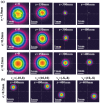Self-steering partially coherent beams
- PMID: 28051164
- PMCID: PMC5209694
- DOI: 10.1038/srep39957
Self-steering partially coherent beams
Abstract
We introduce a class of shape-invariant partially coherent beams with a moving guiding center which we term self-steering partially coherent beams. The guiding center of each such beam evolves along a straight line trajectory which can be engineered to make any angle with the x-axis. We show that the straight line trajectory of the guiding center is the only option in free space due to the linear momentum conservation. We experimentally generate a particular subclass of new beams, self-steering Gaussian Schell beams and argue that they can find applications for mobile target tracing and trapped micro- and/or nanoparticle transport.
Figures





Similar articles
-
Self-steering partially coherent vector beams.Opt Express. 2019 May 13;27(10):14353-14368. doi: 10.1364/OE.27.014353. Opt Express. 2019. PMID: 31163886
-
Controllable rotating Gaussian Schell-model beams.Opt Lett. 2019 Feb 15;44(4):735-738. doi: 10.1364/OL.44.000735. Opt Lett. 2019. PMID: 30767974
-
Partially coherent standard and elegant Laguerre-Gaussian beams of all orders.Opt Express. 2009 Dec 7;17(25):22366-79. doi: 10.1364/OE.17.022366. Opt Express. 2009. PMID: 20052160
-
Scattering of a partially coherent Gaussian-Schell beam from a diffuse target in slant atmospheric turbulence.J Opt Soc Am A Opt Image Sci Vis. 2011 Jul 1;28(7):1531-9. doi: 10.1364/JOSAA.28.001531. J Opt Soc Am A Opt Image Sci Vis. 2011. PMID: 21734754
-
Twisted vortex Gaussian Schell-model beams.J Opt Soc Am A Opt Image Sci Vis. 2018 Nov 1;35(11):1899-1906. doi: 10.1364/JOSAA.35.001899. J Opt Soc Am A Opt Image Sci Vis. 2018. PMID: 30461849
Cited by
-
Optical coherence encryption with structured random light.Photonix. 2021;2(1):6. doi: 10.1186/s43074-021-00027-z. Epub 2021 Apr 20. Photonix. 2021. PMID: 34841255 Free PMC article.
References
-
- Ashkin A. Acceleration and Trapping of Particles by Radiation Pressure. Phys. Rev. Lett. 24, 156–159 (1970).
-
- Ashkin A., Dziedzic J. M., Bjorkholm J. E. & Chu S. Observation of a single-beam gradient force optical trap for dielectric particles. Opt. Lett. 11, 288–290 (1986). - PubMed
-
- Grier D. G. A revolution in optical manipulation. Nature 424, 810–816 (2003). - PubMed
-
- Oroszi L., Galajda P., Kirei H., Bottka S. & Ormos P. Direct measurement of torque in an optical trap and its application to double-strand DNA. Phys. Rev. Lett. 97, 058301 (2006). - PubMed
Publication types
LinkOut - more resources
Full Text Sources
Other Literature Sources

